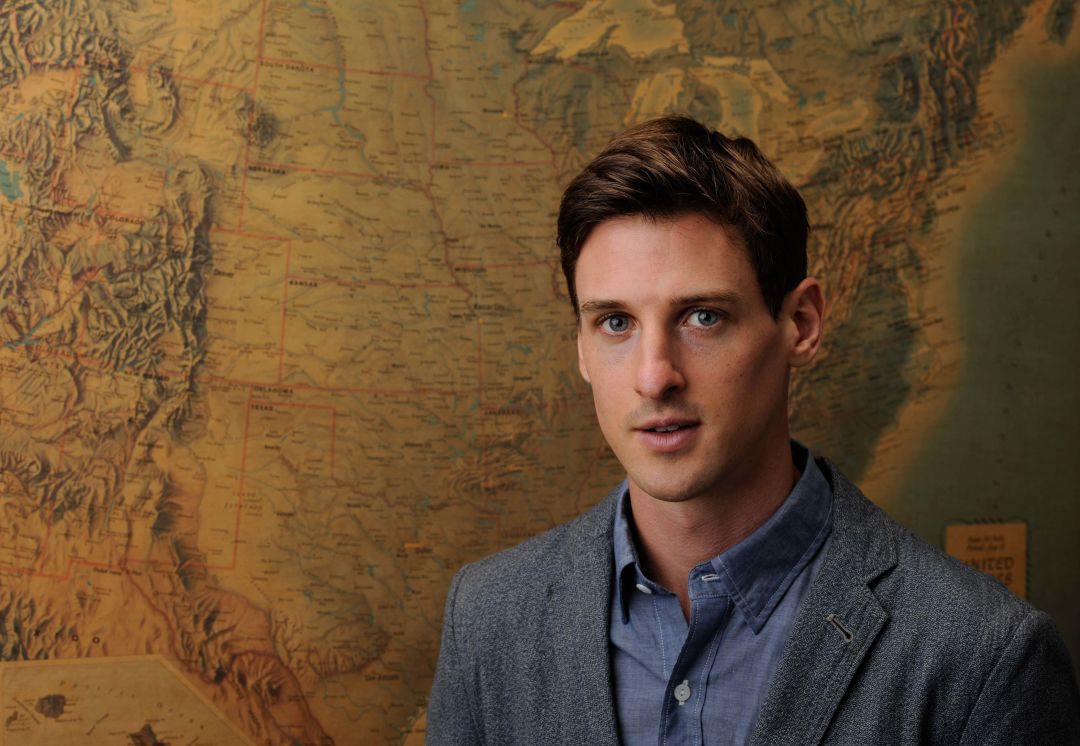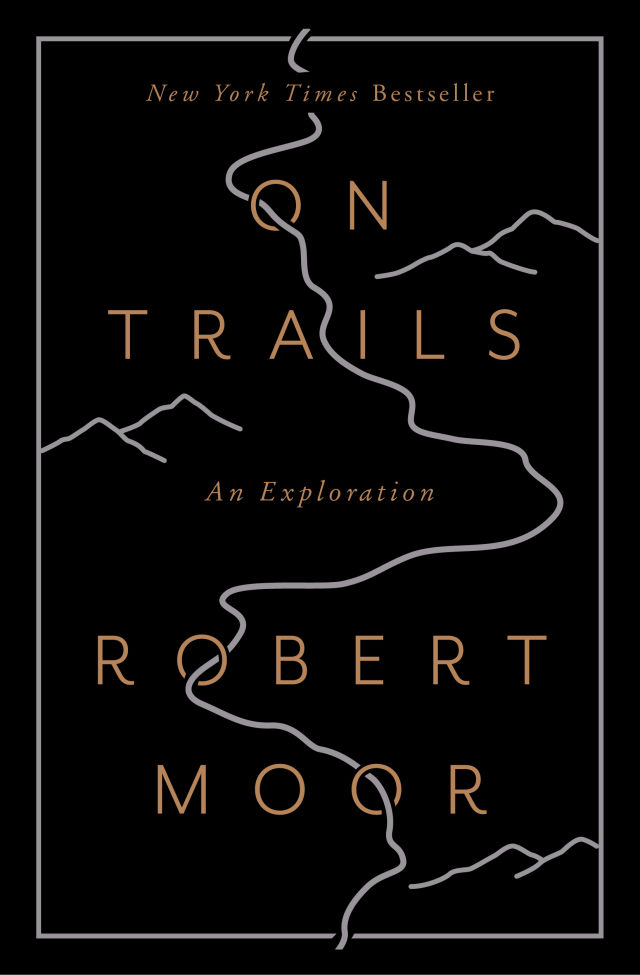Walking the World with Pacific Northwest Writer Robert Moor

Robert Moor reads in Portland on Wednesday, August 2.
Image: Donna Svennevik
Robert Moor has hiked through Tanzanian grasslands and Bornean rainforest. He’s traveled along surviving stretches of the Trail of Tears, and wrestled through Tuckamore—almost impenetrable groves of dwarf spruce and fir—in the pathless fjords of Newfoundland. He’s even trail-scouted in Morocco for the biggest thru-hike of them all: the conceptual International Appalachian Trail, which hops the Atlantic Ocean to Europe and Northern Africa to reconnect what once, in the era of Pangaea, was a single range of Paleozoic mountains.
But prior to his August 2 reading at Powell’s City of Books, the British Columbia-based author of On Trails—a New York Times-bestselling rumination on path-making both literal and poetic, from the pheromone traces of ants to Sequoyah’s ingenious translation of the Cherokee language to paper—will have never set foot in Oregon.
That’s not to say he hasn’t been asked about our state's trails. Toward the end of his recent interview with Portland Monthly, as we veer into the topic of loving our wild spaces perhaps a bit too much, Moor audibly braces himself for what he assumes is the next question.
“You’re going to ask me about the Pacific Crest Trail and Cheryl Strayed, aren’t you?” he interjects. For the record, we weren’t. (Instead, we talked about the end of the world.)

On Trails is the British Columbia-based journalist's first nonfiction book.
Image: Robert Moor
So where are we reaching you today?
My home in Halfmoon Bay in British Columbia—a place called the Sunshine Coast. You take a ferry from Vancouver about 40 minutes, then you drive about an hour up the coast. It’s a lucky thing that we found this spot; our backyard is just forest for a couple hundred acres till you get to the Salish Sea.
You moved to BC in 2013, I think—right after you landed your book deal. How much does the finished product resemble your original proposal?
[The book structure] has been relatively the same from the beginning, which is kind of amazing. It’s funny; I knew from the very moment that I conceived of it that the structure would start very small and ancient and zoom out to something large and postmodern. I knew I wanted to start with insect trails and fossils, and have the scale widening into the present. That’s how I pitched it. Though I didn’t know who I would talk to. You know, book proposals are bullshit. And the weird thing is that no one cares. They don’t fact-check it. You just say, "I’m going to talk to this person," and you don’t have to actually interview that person. I had all sorts of other characters in there who I wanted to interview: a deer hunter up in Maine, and originally the ant chapter was going to be about [ant behavior expert] Audrey Dussutour in France, but you know, it just didn’t work out that way.
Ultimately what I found was the best technique for finding subjects was to find one person and ask them for recommendations. When you’re reading the book you’ll notice there’s a kind of concatenation of subjects: one person leads me to the next. I’m talking to Simon Garnier at the New Jersey Institute of Technology and he leads me to Nidhi Dharithreesan, who’s studying safari animals and African game trails. And from there I moved on to [Alabama bow hunter] Ricky Butch Walker, and Ricky Butch Walker leads me to [trail historian] Lamar Marshall, and from Lamar Marshall I meet [Cherokee language instructor and hiker] Gilliam Jackson. Interesting people tend to hang out with interesting people.
You're about to start a book tour for the paperback edition of On Trails. What else are you working on right now?
When I first conceived of On Trails, I conceived of it as a trilogy. The idea came to me right away. The first would be about trails, the second about trees, and the third about constellations. All three on the topic of how do we make sense of chaos. And not just we, but how does the universe make sense of itself—how does order arise? Three structures: the winnowing of the trails; the relentless branching and pruning of the trees; and the third, the constellation—essentially a random form upon which we consciously apply order. The tree book is my next one, and I’m working on it now. As I go on my tour—Seattle, Portland, and northern California—I’ll be interviewing all sorts of people along the way.
Just wondering, what familiarity do you have with this part of the country?
Unfortunately, none—I’ve never even been to Portland! It’s wild, I’ve never been to Oregon at all. The stars never aligned, which is odd, since I’ve been up here for so long and it’s only, what, an eight- or 10-hour drive? Or less than that… I know I should have probably researched best trails in Oregon before talking with you. A friend—he lives in Portland and writes for the New York Times Magazine a lot—he recently hiked the Oregon Desert Trail. [Explore the first half.]
We love our trails here. There’s the PCT, the Lewis and Clark Discovery Trail, now the Timber Trail, and someday, maybe, maybe, the Infinity Loop…
One of the things that I learned, writing this book, is that those big trail concepts are just incredibly difficult to complete. They’re very easy to dream up, and then the practical implementation of them is just nightmarish, to try to get the easements and the rights to pass through these areas. So ultimately a lot of it ends up being rail trails and roads and things that are pre-existing, which for walkers aren’t ideal. I think it is a golden age for bikers, because of all those rail trails. But have you ever walked on rail trails? It’s just boring—punishing, even, straight as the eye can see. My friend described the Oregon Desert Trail as a “phantom trail.” And that's another trend: the “un-trail,” where there aren’t even markings to follow—it’s just an idea. That’s really compelling.
What other trail-based trends are you observing?
There's a guy in Seattle who is trying to reimagine Discovery Park—to basically rethink the role of the park in the 21st century. The question is, should parks be more technologically integrated or should they be a kind of sanctuary from technological connection? People are already turning to national and city parks to get away from the constant barrage of connection. So how do people designing those spaces deal with that question while still dealing with issues of safety? It’s tricky, and I’m split on it to be honest. Because I turn to wilderness as a sanctuary from technology, and I relish it. A quarter mile from my house, I lose cell service, so I’ll walk back there sometimes every other day to sit and read. But I’m well aware that as a white dude, I have a sort of invisible cloak of privilege that surrounds me in the wilderness, and some people don’t have that. They don’t feel as safe as I do. I’m afraid of a tree limb falling on me, or lightning, or freezing. But I’m not afraid of some crazy person killing me because of my gender or the color of my skin. That is something that I try to not forget when I think about these issues. Cell phones can be a necessary tool of safety.
You've been outspoken—in Outside magazine and other publications—about the need to build more trails in order to better protect wilderness. What do you say to the people who argue we need fewer trails, for the very same reason?
The comment that “we’re loving it to death”—that’s actually a very old tension, the idea that the world is this fragile thing. It is a real paradox. But in my opinion, the bigger danger is underuse. Because you need people to love the wilderness in order for it to continue existing. Two things happen to a trail when it’s too visited: it can become eroded and muddy and too wide, or the builders of that trail can change it fundamentally to allow more people to walk on it. There’s a place in New York called Bear Mountain, one of the most visited places on the Appalachian Trail because it’s connected by train to New York City. At one point, the trail had been completely destroyed by overuse: 30 feet wide, with all sorts of desire lines along different parts of the mountain. Now, there are a lot of stone steps; the builders had to completely reengineer it. It’s akin to paving a road, and that’s a good thing and a bad thing. It is no longer a completely wild space. But having a mix of spaces—some easy to access—it can allow the surrounding land to be unscathed.
OK, so what is the biggest problem?
Oh my god. Climate change? Impending ecological collapse? I’m not a nature writer per se—more adjacent to it. But I think you’re going to see a turn toward more politically urgent writing. Just walking around in the forest and thinking about all the beautiful plants and what not, that’s no longer as appealing as it was, pre-Trump. Previously, I would have been more comfortable writing about trees in a universal way. But now it feels urgent to me to think about them in a way that can serve as a call to action. Something that is highly political can feel like propaganda to people, and they can tune out. But I get a feeling now of, who cares? The world is on the brink. You have a complete buffoon for a president who is hellbent on tearing everything apart. It was always urgent, but I guess I was able to delude myself into thinking that other people could take that on, and I was free to just think about all the beautiful stuff.
Robert Moor
7:30 p.m. Wed, Aug 2, Powell's City of Books, FREE




